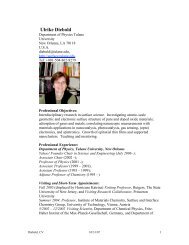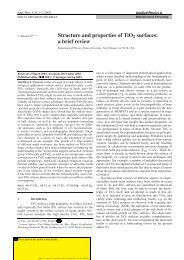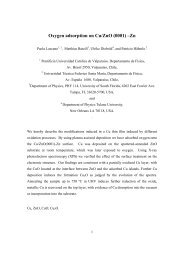The surface science of titanium dioxide - Niser
The surface science of titanium dioxide - Niser
The surface science of titanium dioxide - Niser
You also want an ePaper? Increase the reach of your titles
YUMPU automatically turns print PDFs into web optimized ePapers that Google loves.
64 U. Diebold / Surface Science Reports 48 (2003) 53±229<br />
Table 1 (Continued )<br />
Refractive index, n, <strong>of</strong><br />
rutile single crystal<br />
for ordinary(1) and<br />
extraordinary(2) rays<br />
in visible and IR<br />
regions <strong>of</strong> spectrum,<br />
at 298 K<br />
0.20 3.0 1223<br />
0.30 4.0 1223<br />
0.32 5.0 1223<br />
0.50 6.0 1223<br />
0.67 7.0 1223<br />
0.76 8.0 1223<br />
0.80 9.0 1223<br />
0.84 10.0 1223<br />
0.85 11.0 1223<br />
0.86 12.0 1223<br />
0.87 13.0 1223<br />
0.88 14.0 1223<br />
0.89 15.0 1223<br />
a Data from [65] unless noted otherwise. A more detailed compendium <strong>of</strong> bulk properties <strong>of</strong> rutile is given in [49].<br />
on two complementaryelectrodes (TiO 2 and WO 3 in the case <strong>of</strong> [57]), which change their color upon<br />
reduction/oxidation cycles induced by an electrical current.<br />
Polycrystalline ZnO, TiO 2 and SnO 2 , exhibit a high non-linearitybetween the current densityand the<br />
electric ®eld and are thus suitable as `varistors' for the suppression <strong>of</strong> high transient voltages [58].<br />
Doped TiO 2 ceramics have useful varistor properties with non-linearitycoef®cient (a) values in the<br />
range a ˆ 3 12, a being de®ned bythe relationship I ˆ KV a , where I is the current, V the voltage, and<br />
K the proportionalityconstant. <strong>The</strong> presence <strong>of</strong> this potential barrier is due to the creation <strong>of</strong> defects<br />
formed during sintering <strong>of</strong> TiO 2 systems. A potential barrier associated with a double space charge<br />
distribution can originate at these defects. This phenomenon establishes variable resistance as a<br />
function <strong>of</strong> the applied electric ®eld to the solid.<br />
Metallic implants in the human bodyhave a signi®cant economic and clinical impact in the<br />
biomaterials ®eld [59]. `Commerciallypure' (CP) <strong>titanium</strong> (ASTM F67) and `extra-low interstitial'<br />
(ELI) Ti±6Al±4V alloy(ASTM F136) are the two most common implant biomaterials. <strong>The</strong>re is an<br />
increasing interest in the chemical and physical nature <strong>of</strong> the oxide layer on the <strong>surface</strong> <strong>of</strong> both<br />
materials [60]. <strong>The</strong> oxide provides corrosion resistance and mayalso contribute to the biological<br />
performance <strong>of</strong> Ti at molecular and tissue levels, as suggested in the literature on osseointegrated oral<br />
and maxill<strong>of</strong>acial implants byBranemark, Kasemo and co-workers [61] in Sweden.<br />
1.3. Outline <strong>of</strong> this review<br />
<strong>The</strong> geometric structure <strong>of</strong> various TiO 2 <strong>surface</strong>s is discussed in Section 2. A detailed knowledge <strong>of</strong><br />
the <strong>surface</strong> structure is the crucial ®rst step in obtaining a detailed knowledge <strong>of</strong> reaction mechanisms







